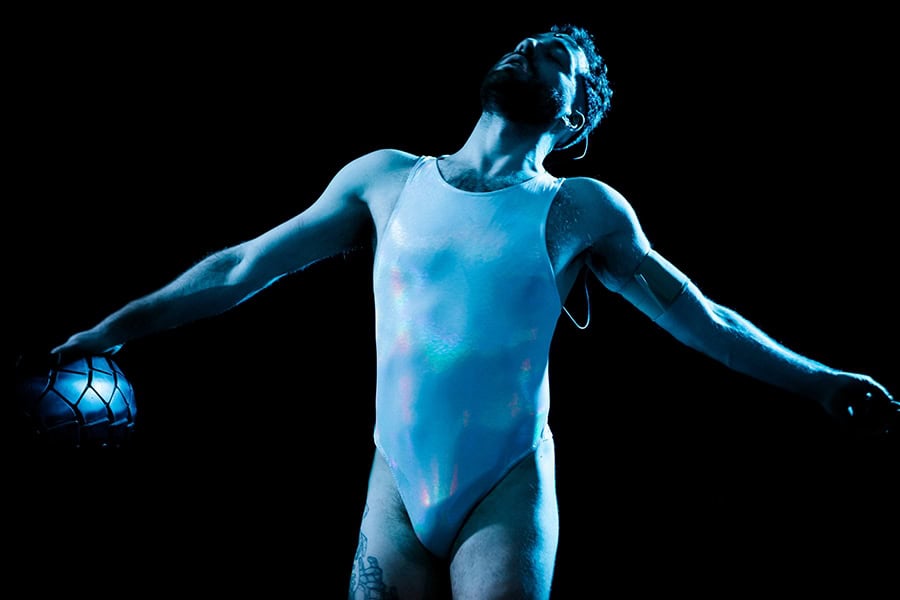Dam Van Huynh, In Realness, Rich Mix
Posted: August 2nd, 2022 | Author: Nicholas Minns & Caterina Albano | Filed under: Performance | Tags: Dam Van Huynh, Emma Lyth, Ian Tang, Patricia Roldán Polo, Tommaso Petrolo | Comments Off on Dam Van Huynh, In Realness, Rich MixDam Van Huynh, In Realness, Rich Mix, May 14

Picture Tommaso Petrolo standing in a white leotard on the bare stage in Rich Mix nonchalantly holding a black rubber tyre on one side. And as we are watching him in the silence, he is watching us, intently, one by one, switching focus in small degrees like a bird. He keeps his gaze on one or two — friends, perhaps — with a faint smile of complicity. We are also watching with growing intrigue how choreographer Dam Van Huynh is handling the beginning of his new work, In Realness. The image of Petrolo is stark yet alluring, brash yet modestly restrained. It’s an anomaly of muscular energy and macho posture in balletic guise, masculine yet feminine at the same time without being camp. To instruct such an image to move would be to disavow its carefully conceived ambivalence. Van Huynh resolves the issue by choreographing for Petrolo’s voice rather than for his body, and once his voice is set in virtuosic motion, the body becomes its natural corporal partner.
That Van Huynh gives the voice such preference in a choreographic work is because In Realness is his attempt to make the body an instrument of rhetoric, the classical study of the persuasive and expressive forms of language. Here, the ‘logos’ is provided through a script; Van Huynh’s authorship is shared through the creative team of Ian Tang (composition), Patricia Roldán Polo (lighting) and Emma Lyth (costume), and the emotional charge is derived through the medium of Petrolo’s performance.
Van Huynh’s script, made available to the audience, is a wide-ranging collection of citations from poets and activists who have inspired him, from Walt Whitman and Henry David Thoreau to Audre Lorde, Alok Vaid-Menon (ALOK) and Pussy Riot. In an interview Van Huynh conducted with Grace Nicol about the genesis of In Realness, he says he wanted ‘to create a body of resistance against oppressive norms and behaviours and to amplify our resilience. As a queer Vietnamese artist, I began the research commenting on gender politics and sexuality but as the work developed it became a larger symbol for inequality experience by many groups.’
The directness of the selected citations is already a powerful argument. Words may sit immobile on a page but they can excite movement in the brain. Walt Whitman’s appeal from Leaves of Grass to ‘Resist much, obey little’ contains a world of anti-establishment sentiment, while Audre Lorde’s admonition from Learning from the 60s is an irrefutable statement to the disenfranchised: ‘We share a common interest, survival, and it cannot be pursued in isolation from others simply because their differences make us uncomfortable.’ Pussy Riot loads the satire of its lyrics to Organs with punk aggression: ‘…bodies, bodies, bodies, My pressey replaced his dick with an ICBM. Freedom and bondage is the same shit now…’ ALOK’s advocacy of ‘an interconnectivity of not having to formulate your body as a pre-existing algorithm or equation’ is a key argument of Van Huynh’s questioning about sexuality and gender that initiated his research. And in terms of an overall call to freedom from any form of oppression, Thoreau’s famous quote is added to the script: ‘The best form of government is no government at all and that is what we’ll have when we are ready for it.’
The voice is a physical organ that sits somewhere between mind and body; Van Huynh choreographs for both with such force that Petrolo’s performance is exhausting and uplifting at the same time; his verbal acrobatics and the sheer energy with which he delivers his texts in various states of balance is prodigious. He manifests strength, power, and engagement as qualities that are shared with the qualities of the text. But it is the force of Petrolo’s exposition that we remember, its repetitions and intonations, rather than the clarity and continuity of what he says. Hence the importance of the script as a reminder of the work’s genesis. In Realness is the manifestation and release of Van Huynh’s built-up resistance but the vital path of its process is subsumed in the sound and fury of its performance. In Realness has all the essential elements of rhetoric — its argument, its authorial credibility and its emotional appeal — but the co-mingling of the three is not fully realised or focused. It chases its own tail in spectacular fashion while fragments of its cohesion tend to fly off at a tangent. But later, in the silence, when we put all the pieces back together, we find there is nothing missing.